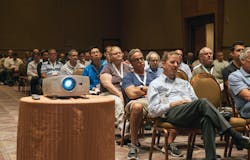BICSI Field Report: 2013 Fall Conference
Held September 15-19 at the MGM Grand Convention Center in Las Vegas, the BICSI 2013 Fall Conference drew more than 3,800 attendees plus exhibitors and visitors. During both the educational sessions and on the exhibit floor, IT professionals reviewed a number of developments including data center operations, BIM adoption, and 2014 National Electrical Code changes.
Throughout the conference, BICSI Cares, BICSI’s charitable arm that supports children’s charities, collected donations from attendees. All funds collected were donated to Teen with a Dream, a charity that helps to enrich the lives of pediatric cancer patients and their families. During the Closing General Session on Thursday, a donation check was presented to Teen with a Dream founder, 24-year-old Spencer Harrison, who started the charity at 14 when he was just two weeks into his cancer treatment. Now cancer free, Harrison continues his charity work to support families of children fighting the disease.
Following the BICSI Cares presentation, Don Yeager, an award-winning keynote speaker, business leadership coach, seven-time New York Times best-selling author, and long-time associate editor for Sports Illustrated delivered the closing keynote address. Following are some key conference observations and industry trends gathered at this year’s event.
Conference highlights
With the potential to reshape economies, the Internet of everything (I of E) — or "the age of devices" concept, which in 1984 could count only about 1,000 things connected to the Internet — will reach 50 billion by 2020. And with the proliferation of IP-enabled devices — from telephony and building automation to access control and security systems — the need for well-trained, proficient cabling, and equipment installers is becoming ever more important. A cabling professional should pursue education and certification training even in areas not previously considered, such as security or audio/visual installations, as was demonstrated in many seminars and forums during the BICSI meeting.
Network designers and cabling installers were eager to learn more about how new wireless technologies will impact networks in the future. Wireless LANs, which have been operating at a few hundred Mbps, will soon expand into the Gbps range to handle the growing number of mobile users, devices, and expanded applications, such as video. One forecast, based on the 2013 Cisco Networking Index (VNI) report, says that by 2016, wireless and mobile data traffic will exceed wired circuit traffic, thus challenging both private WiFi networks and public-service provider cellular networks. To support this growing mobile data demand, the density of access points in the wireless LAN will continue to increase.
An important part of meeting this growing demand will be the use of emerging IEEE 802.11ac and 802.11ad amendments to the wireless standards as a way of achieving Gigabit transmission speeds. The 802.11ac upgrade promises to deliver a total of 495 MHz, while operating solely in the 5 GHz frequency range and with some changes in the network protocols. To reach this goal, vendors are devising new signaling techniques as many organizations are expanding their indoor and outdoor wireless networks in anticipation of wireless going beyond Gigabit speeds.
This brings up the subject of achieving adequate wireless coverage both indoors and outdoors by using a technology called a distributed antenna system (DAS), which modifies, improves, or extends coverage by bringing carrier signals directly into a building and by having the transmitted power divided among several antennae (rather than a single antenna). According to a recent forecast from SNS Research, the market for DAS equipment will grow at a compound annual growth rate of nearly 11% over the next five years and account for nearly $4 billion in revenue.
Educational sessions
In "The Last Yard: Optical Fiber for Next Generation Digital AV Cables," Devang Parekh, Cosemi Technologies, Santa Clara, Calif., discussed the trend toward larger video displays and higher resolution imaging, such as 4K broadcasting, which offers four times the resolution of today's high definition (HD) transmission — and the fact that audio/visual (AV) data rates are approaching that of standard data transmission rates. Copper cabling will be the dominant cabling media for short-distance connections for about five more years; however, better solutions are needed for higher data rate applications and longer distances.
In "DAS and Small-Cell Solutions: Deployment Trends that Impact Your Business," Tracy Ford, the HetNet Forum at PCIA, Alexandria, Va.; Allen Dixon, Corning Mobile Access, Hickory, N.C.; and Jamie Dahlgren, AT&T Antenna Solutions Group, Dallas, discussed the complex challenges involved in setting up wireless communications. Because more than two-thirds of wireless traffic is generated indoors, soon web traffic from wireless and mobile devices will surpass the volume of traffic from wired devices. Although deploying a DAS can be a complex undertaking, the DAS market will more than double in size over the next five years with a dramatic increase in the combination of DAS with Wi-Fi, public safety radio, and LTE networks. This, in total, would include 2G/ 3G/4G plus 802.11ac/ad technologies. The presentation noted that some indoor wireless installations will be required to integrate with expanded life safety codes (first responders) and federal, state, and municipal regulations regarding areas such as power backup.
Small cell is an imprecise term used to describe any RF source smaller than today's base station. Three types of "small cells" — low powered antennae — were discussed: microcell (a 2-km-wide distribution pattern; picocell (a 200-m-wide pattern); and femtocell (a 10-m-wide pattern). To serve a dispersed layout of small antenna, extra fiber, coax, and Gigabit Ethernet copper services are recommended in risers between floors and in conduit across the building, along with adequate space, AC power, and HVAC services in telecom closets.
Future wireless technologies were also described under the titles of cellular technology consolidation, 60-GHz spectrum adoption, and WiFi Evolution. To meet the growing demand for wireless services going forward, a number of different technologies mentioned in the presentation most likely will coexist in a building or campus, forming what are called heterogeneous networks or HetNets.
In "Modernizing Health Care Infrastructure with Proper Project Planning, Systematic Implementation and Concise Phasing," Brian Bates, DWG, Inc., Mount Pleasant, S.C., described the rewiring of every network and voice connection in an existing 750,000-sq-ft, 453-bed aging hospital without disrupting service to the operating rooms and patients. Project planning involved the use of building information modeling (BIM) to show the owner 3D views of the various spaces and to facilitate the coordination in 3D images of all mechanical, electrical, and plumbing systems with the architectural structure.
One challenge was that changes to NFPA 99 Health Care Facilities Code (2012 edition), requires some communications systems in hospitals to be as reliable as emergency power in operating rooms. The new design meets current and future needs regarding computer-based information systems supporting electronic medical records, innovative treatments, and advanced diagnostic equipment. All new copper and fiber cabling runs were installed to about 75% of the facility from 18 new telecom rooms, which feature lockable racks, a card access system, video surveillance, and IPPA/security. A centralized uninterruptable power supply system serves the facility, and the new data center has a comprehensive grounding system, static resistant flooring layout, and in-row cooling of the equipment racks.
In "Understanding the Promises and Capabilities of DCIM," Charles Kramer, Emerson Network Power, Coatesville, Pa., explained the concept of data center infrastructure management (DCIM), which is to integrate the information technology (IT) and facility management disciplines to achieve centralized monitoring, management, and capacity planning of critical systems over time. A broadly used term covering a wide range of data center management values, DCIM's job is to make the data understandable, relevant, and actionable — so that it can be acted upon. Software collects important information, such as electric power, HVAC, and processor use.
In "The New Face of Design: Building Information Modeling and what it Means to the AV Industry," Jon Melchin, FRS, Inc., North Andover, Mass., described how BIM is changing the standard design practice in architecture. Many organizations worldwide are promoting adoption of BIM (an object-oriented building process), which integrates all stakeholders — not just construction managers, architects, and engineers — on a project. Melchin noted that AV products are considered building components, or BIM "objects" today, and should be considered as important components in making a project successful.
Visual simulation can detect potential problems such as AV space and system conflicts (such as the placement of loud speakers and presentation screens) and inadequate projector and cameral sight lines. It can also bring attention to natural daylight entering the space, such as in a meeting room, which can compromise visual clarity. Along with a 3D view of a complex structure, BIM can present information that can generate reports, schedule simulations, and deliver facilities management and life cycle analysis.
The San Francisco-based Letterman Digital Arts Center, an 865,000-sq-ft film production facility owned by Luca Film, which is supported by 600 miles of fiber-optic cabling, was presented as a case study. The use of 3D modeling within the BIM software program uncovered hundreds of conflicts, resulting in cost savings of $10 million. Despite numerous design changes, the project was delivered on time and under budget, largely do the conflict resolving features of the software.
In "Pathways for Cabling Infrastructure," David Landphair, CADDY Data Telecom, and Dr. Ward Judson, ERICO International Corp., Kernersville, N.C., focused on the codes and standards, such as TIA 568C, TIA 569C, the NEC, and other references, associated with horizontal and vertical pathways for copper and fiber cabling while also describing the best practices in use of support materials and fasteners. The need for wide-based support for all non-continuous assembled pathway supports, which should be UL-listed, was stressed. In addition, non-continuous pathways must conform to the requirements of Sec. 300.11 of the 2011 NEC above the ceiling grid, and all suspended ceiling applications must have visually distinguishable independent support wires affixed at both ends.
In "The Growing Need for Mass Notification and Emergency Communications (MNEC) Systems," David Smith, Lencore, Woodbury, N.Y., described the growing importance of mass notification systems in recent years because of tragic events in public facilities and the need to inform all building occupants during these emergency events. Proving real-time information, MNEC offers adequate coverage for areas, such as open and closed office areas, cafeterias, or call center floors, and it can be expanded to also serve areas such as bathrooms, stairwells, mechanical rooms, loading docks, rooftops, and garages. Traditionally mass notification has involved the use of paging speakers and strobes, often duplicating the operation of a fire alarm system. Today, however, with the adoption of the 2010 Edition of NFPA 72 National Fire Alarm and Signaling Code, as well as the emergence of new technologies, more effective and inclusive ways of communicating during an emergency event can be specified, such as digital displays, light bars, e-mail or texts. Additionally, MNEC systems have the capability of receiving RSS feeds, such as weather reports, to offer timely warnings.
For more images of the BICSI 2013 Fall Conference in Las Vegas and additional show details, browse the exclusive photo gallery.
About the Author
Joseph R. Knisley
Lighting Consultant
Joe earned a BA degree from Queens College and trained as an electronics technician in the U.S. Navy. He is a member of the IEEE Communications Society, Building Industry Consulting Service International (BICSI), and IESNA. Joe worked on the editorial staff of Electrical Wholesaling magazine before joining EC&M in 1969. He received the Jesse H. Neal Award for Editorial Excellence in 1966 and 1968. He currently serves as the group's resident expert on the topics of voice/video/data communications technology and lighting.


